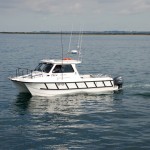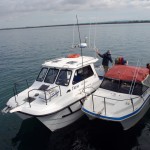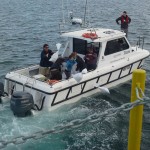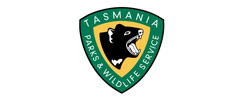Wednesday 2 May 2012
“Trim” was the name of Matthew Flinders’ cat on his historic 1802 circumnavigation of Australia. This nondescript black and white kitten provided solace and support to the captain and crew, and a few heart-stopping moments when it took flying leaps through the air in the rigging.
Our Trim is also a black and white cat, but hardly nondescript. She is an 8 metre long Kevlacat, purpose-built as a diving and support vessel for Heritage Victoria, and like her namesake, provides succour and support to the crew of our isolated barge. She fills the roles of transport barge, personnel carrier, dive support boat and rescue boat – in Navy parlance, a “Crash boat”, but given the weather we have been having, she’s also becoming known as the “Bang-and-Crash Boat”.
 |
 |
 |
 |
| Michael Gregg | Trim on a nice day (photo by Andy Viduka) | Trim rafted up alongside the barge (photo by Andy Viduka) | Trim over Clarence dropping sandbags (photo by Jen Rodrigues) |
A good day starts around 5 am when bleary faces emerge to gloomily contemplate the weather and start the grim search for a coffee plunger. By about 5.45 the boat team (at the moment Peter Harvey, divemaster extraordinaire and barge captain James Parkinson, the first four divers rostered for the day, myself, and anyone else conned into getting out of bed so early) are in the truck towing the boat to the ramp at Queenscliff, 22 kms away. By dawn we’re in the water and bashing our way out to the barge. And then the fun begins.
The first task of the day is to check the local conditions at the barge – often wildly different to those on shore – and determine the viability and safety of transfer and diving operations. If James and Pete give it the ok, the next job is to transfer the barge crew and the many, many crates of diving gear up the four metres to the barge deck. Easier said than done. The boat landing is a 1.5 by 1 metre square scaffold platform descending off one end, and getting those crates transferred takes skilled boat handling.
Trim, like most dual-engined catamarans, is brilliantly manouverable in good conditions – able to rotate in her own length and roar off at 40 knots in any direction. But she has foibles. Her large and comfortable wheelhouse gives her great resistance to the wind forward, but very little grip on the water. Her low stern gives little wind resistance, but great grip in the water. The end result is that when the wind is blowing the opposite direction to the fast tide, coming alongside that tiny platform gets tricky. With the wind blowing the bow one way and the tide dragging the stern the other, a deft – and quick – hand on the throttles is required. Maestro Peter Harvey, her regular skipper, makes this look a doddle. For us mere mortals, this requires great concentration, and a few goes at it. All of this is done in the short, steep and surprisingly difficult chop for which Port Phillip Bay is cursed.
Then it’s off to the St Leonards boat ramp or pier, depending on the weather conditions, to transfer the first of the up to 25 people working on the shift on the barge – and the often delicate specialist equipment of the finds recording and conservation team.
Transfers completed, the boat crew gets to lie off on standby, with a grandstand view of the hive of activity on and under the platform. On a clear day we can actually see the divers working underwater on the wreck, and of course trace the patterns of the bubbles and brightly coloured umbilicals as they move about.
Life is not boring on the mooring. Whilst we have not been called out to rescue any diver caught in the current, we have had to zoom off to rescue the occasional errant fin or other equipment snatched away from the divers by the current over the site – you try picking up a standard urine sample jar with just a boat hook!
And the other role is to ensure the safety of both the site and the divers from the sometimes extraordinarily irresponsible operators of recreational boats who seem utterly unaware of the 100 metre gazetted exclusion zone around the Clarence wrecksite, and even more alarmingly, the significance of the prominently displayed dive flags. Needless to say, some of the more alarmingly irresponsible boaters will be receiving an unwelcome surprise in the mail.
A “weather eye” is also kept on the weather, from both boat and barge. If the notorious black line appears on the horizon, diving is stopped, and the organization and discipline on the barge becomes rapidly apparent as the whole operation is shut down, packed away, and locked up, and crew transfers to Trim begin. Then she shows her true colours as she bounds away to St Leonards, like her namesake taking to the air for a heart-stopping and exhilarating ride – a “bang and crash boat” indeed. But that’s on a good day. Sadly, they seem a distant memory as we sit for the third day watching the mud slides in the rain at the campsite… Tomorrow is another day….
by Michael Gregg WA Museum – Maritime History Department Western Australia
















